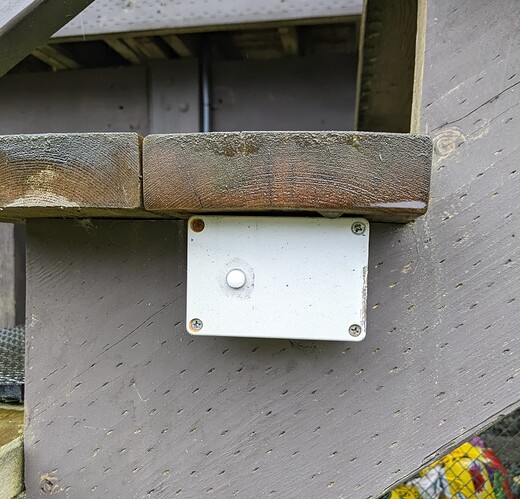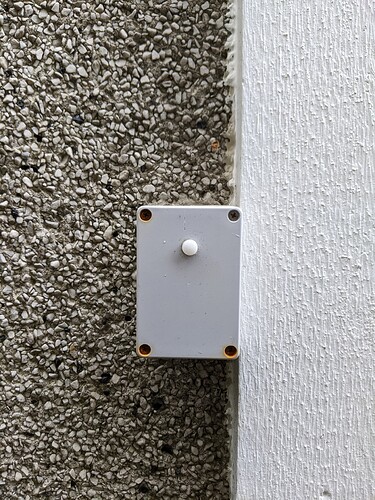I looked too and wound up with Hue.
I spent even more because I don't like worrying about batteries and purchased plug-in battery adapters for mine and ran wires. (Yes, I know it can be done cheaper)
That's a good idea. Both of mine are in locations that power is easily available.
Made by Hue?
No, I'll post a link to what I used, but it can be done way cheaper..
Interested in that info as well...I do have a line buried in the front yard that could provide power to one of my Hue outdoor motion sensors very near that spot.
Lenink AC Power Supply Adapter for AA Battery, Replace 2 AA Battery for Led Lights, Decorations (White, 1.8m/5.9ft) Amazon.com
If you live in SoCal, fire, smoke, and heat might be more of an issue than rain and wind.
I live in Northern Illinois where we can get wind, rain, hail, snow, ice, fog and temperatures that range from 20 below zero up to over 100 degrees F. An indoor sensor wrapped in Saran wrap is not likely to do well in that environment.
Likewise, those in the Southeast who are subject to hurricanes need a sensor well protected from rain driven by high winds.
That is why outdoor sensors are more costly to produce than ones for indoor use.
There’s sufficient warning with hurricanes and tropical storms that I just remove externally placed sensors and devices. And use bungee cords and bricks to tie other things down.
Somewhat different than dealing with tornadoes in the Midwest.
I modified the Iris v2 motion sensors and put it inside a PVC box with 2 C cell batteries. Been out there for around 5 years now. Batteries change out once a year.
I tried with the Smarthings sensor but that thing is junk with crazy false alarm.
I know you said Zigbee, but if that's not a dealbreaker, the Zooz ZSE29 is Z-Wave and is sometimes cheaper than Hue (Zooz has sales on occasion, not sure about right now or what the stock is). Otherwise, depending on where you live and how sad you'd be if the motion sensor died, some people just take the risk of using "indoor" sensors outside. If it's reasonably protected, say, under a porch, even non-enclosed, you might be fine. I've also seen people coat the outside with a silicone spray to waterproof (and whatnot) things a bit or even coat the internal circuit board with a conformal silicone coating (leaving the battery terminals exposed, of course). Just depends on your tolerance for risk, I suppose. ![]()
It sounds like you may have already tried something like that, so then there are a couple of other things to consider. If you can't face the sensor a different direction or "sheid" it a little bit from direct sun (these are pretty much all infrared-based sensors and will be tripped by changes in sunlight from time to time during the day), you could use multiple sensors and use something like Zone Motion Controller to combine them into effectively one sensor that only trips if a certain threshold is met.
Or, related to this concern from another poster:
Why not just "restrict" the automation the sensor is being used for during that time? For example, I have a sensor outside one of my doors that turns lights on with motion--but it only turns them on at night. There are many false motion events throughout the day, and...I just ignore them because they don't matter. ![]() (Of course, this is different if you're trying to use it for "a person is here." But then the idea of combining multiple sensors might work, or perhaps there is another way to reach that goal with something else.)
(Of course, this is different if you're trying to use it for "a person is here." But then the idea of combining multiple sensors might work, or perhaps there is another way to reach that goal with something else.)
As per usual, my solution (that I've used for years), is a nodemcu/konnected and a cheap-■■■ standard ac pir detector.
Cheap as chips. Works ace.
$40 for refurbished. I've bought two refurbished Hue outdoor sensors and have had no issues with either. I frequently purchase Hue devices used. Never had a problem from doing that.
You can get two new from Costco for $79, IRRC.
Link to pics/info?
Those are so cute I'm about to die. Seriously, really nice job, looks great. Those v2's are great sensors, and repurposing them for outside like that is very cool.
I also have one of these that I have been testing. It has been reliable, but I think I'm getting quicker response from the Hue sensors. I'm personally leaning more towards Zigbee, but if I wasn't, this seems like it would be ok.
Thanks, good tip. Although I'm in the UK – Amazon UK only seem to knock 20-25% off for refurbished electronics generally – but I'll keep my eyes open for such deals!
Thanks. I'll have to look into that. I've yet to create any really customised elements in my smart home, but maybe it's time to take that leap. I do already have some separate experience with other (non-smart-home-related) ESP/Arduino/Pi projects so I'm sure it wouldn't be beyond me to figure it out.
(Indeed, one Arduino-based project I designed and made some years ago was an 18-way plant pot moisture monitor & watering system. In the back of my mind, I have been thinking ultimately I'd like to build something similar that connects to Hubitat. But I've yet to look into what would be the best approach.)
We were evacuated once some years back...as I was signing into the hotel register I noticed, oh, yeah, it's my birthday. ![]() Crazy. Luckily didn't lose anything, just a small amount of damage to some tiles on the roof, and ash freaking everywhere.
Crazy. Luckily didn't lose anything, just a small amount of damage to some tiles on the roof, and ash freaking everywhere.
Nothing requiring an evacuation since then, and local government and utilities have been doing a much better job monitoring and proactively turning off power when wind and temperatures create higher risk. But temperatures are going up and rain is disappearing, things are going the wrong way.
Sorry, in a bit of a rush.
If you search my profile I've made plenty of posts about the same kind of thing. I'll never quite understand the fascination with expensive custom smart products when (for me) most of this can be achieved very, very easily and very, very cheaply.
The answer I've heard back prior to this, is that people don't want the inconvenience of needing to send power to various locations round the home. And obviously, this solution is wired.
Search for konnected on this forum. It's a doddle. Essentially, buy a few cheap nodemcu's (WiFi) and flash with konnected to link into hubitat.
Each needs powering with a dc supply. Personally though, I use a single 30amp psu (12v) and drop down to 5v at the point of each nodemcu with a cheap 12v-5v USB device.
Inside, I use standard home alarm style LC pir's powered by the 12v linked to the konnected boards via the NO/GND on the pir's. Cost about 8 quid each, work ace.
Outiside I use the same approach, but via an ac relay to detect when the external AC pirs (about a tenner, screwfix) are activated.
All very, very cheap.
Very, very reliable.
Utter doddle to replace with off the shelf parts as opposed to seeking advice for the current recommendation for a replacement 50 quid smart sensor because your precious favourite is no longer manufactured. Stuff that. I like simplicity and reliability.
But each to their own.
I use the exact same approach for standard ac trvs on my central heating system, and various other projects including door/window contact sensors etc. Never needed to adjust. Their all ace.
IMO, for me, zigbee etc is utterly overrated and overpriced. This gear does the job, does it well, and doesn't require battery replacement. And more importantly, costs about 2% of the custom equivalents when adding multiple contact sensors etc. To be totally clear, I have say, one single nodemcu near the front entrance. This controls door contact sensor, indoor pir, radiator in entrance hallway and a 12v keypad for arming shm. Oh, and a temp/humidity sensor. Keypad cost a tenner, BTW. Total cost for that would run at around 30 quid. Tell me how much that would be to recreate with some version of a zwave keypad, motion sensor, contact sensor and humidity. I know my preferred route.



